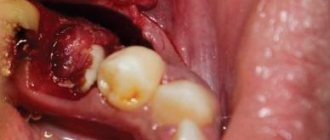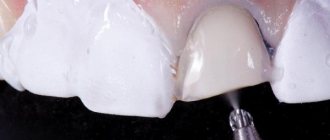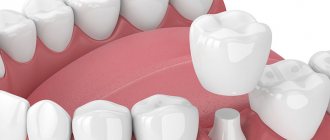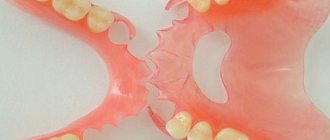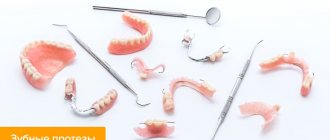Cements
Classification by chemical composition
1) zinc phosphate
2) polycarboxylate
3) glass ionomer
4) polymer-modified glass ionomers
5) composite.
Classification according to the type of reaction on which the solidification process is based
— Cements with acid-base hardening reaction (groups 1–3)
— Cements with polymerization reaction (5th group)
— Polymer-modified glass ionomer cements, cured through a combination of acid-base reaction and polymerization (4th group).
Indications
— Structures on metal frames with a stump height of more than 5 mm – 3rd group of cements;
- All-ceramic structures, structures on metal frames, with a stump height of less than 5 mm - 5th group of cements.
Silicone impression materials
Tweet Today we’ll talk about one of the most important tools of an orthopedic doctor - impression material . And perhaps the most common impression material is silicone .
Silicones are divided according to the type of vulcanization of the material:
polycondensation or addition process.
C-silicones (condensation)
A-silicones (addition)
They are labeled like this on the packages, but in fact they are easy to distinguish by their appearance:
C-silicones are a large jar of mass and a tube of hardener, if this is a base. If this is a correction mass, then a large tube with correction and a smaller tube with a catalyst.
For A-silicones, the base always looks like two identical-sized jars with two different colored masses, and the correction always looks like two identical-sized tubes (except for automatic mixing systems).
It is very important to take into account that with silicones, and indeed with any other impression compounds, optimal properties can only be obtained by strictly observing the proportions specified by the manufacturer. The requirement for precise dosage of components is universal not only for impression materials, but also for all other dental materials.
For example, with C-silicones, an excess of catalyst leads to too rapid formation of a polymer network and, as a result, a serious increase in internal stress. Many doctors justify the excess of catalyst by the need to speed up the process. Yes, the process will speed up, but the doctor or his assistant may not have enough time to fully mix the components. If you feel that the mass has become a little more elastic in your hands - that’s it - it means that the polymerization process has begun and you are already too late. In this case, inserting a spoon into your mouth and taking dental impressions is pointless; you will not get a high-quality impression, since the stresses inside the mass will necessarily deform the impression. In another case, if you are in a hurry and do not mix the impression mass to the desired consistency, the catalyst will be unevenly located, which will again cause internal stress and deformation, due to the presence of areas of the impression mass of different density and again will not give you the opportunity to make a high-quality impression .
Using less catalyst when taking impressions to slow down the process of making impressions (for example, a doctor wants to have time to take a high-quality impression from 14 units at once) causes the same problems, if not worse. Due to the lack of hardener, polymerization will be incomplete, which will affect the firmness and elasticity of the mass and will lead to a violation of the accuracy of the impression when removing it from the oral cavity.
First group: C-silicones
C-silicones vulcanize through a polycondensation reaction. This means that during the vulcanization process, alcohol molecules condense (hence the name polycondensation), which then evaporate. As a result, shrinkage of the material progresses over time. Fillers inside the mass, as inorganic substances, are not subject to shrinkage, so its degree does not depend on their composition and quality. Consequently, more viscous silicones, due to the large amount of filler, have less pronounced shrinkage than silicones with medium and especially low viscosity. Translated into Russian, this means that the correction mass shrinks much faster than the base mass, which inevitably leads to deformation of the print. To simplify it even more, I’ll just say that you need to cast models from impression compounds made with C-silicone as quickly as possible!
Silicones appeared abroad back in the 50s and 60s. They came to us, as a rule, later, somewhere in the late 80s, and even then they were represented mainly by domestic and Czech impression materials. Later, others appeared, for example, “Dentaflex”, “Xantopren”, “Optosyl” and others. Then liquid was used as a catalyst. The base was watered with this catalyst and mixed by hand. Sometimes I had to add liquid until the base began to set. Almost like alginate, only here half of it flowed down the hands onto the robe and onto the floor :). In general, there was no need to talk about the accuracy of the dosage at all, everything was done by eye, and no one could ever say how many drops were absorbed into the base, how many into the hands, and how many evaporated. One could also talk about the quality of the cast conditionally. The correction was cured with the same drops with all the consequences. The shrinkage was monstrous, it was recommended to cast the models immediately after receiving the impression, otherwise serious deformation would occur, the impression would simply dry out very quickly and shrink, so the casting, which fit perfectly on the model, would shrink in the mouth with a terrible creak. The corrective mass did not like moisture very much, which caused bubbles to appear in the most important places.
Over time, more decent materials appeared, for example “Zeta+” . They no longer had a drip catalyst, but a jelly-like catalyst, which was much easier to dose, and as a correction it was accompanied not only by a liquid mass, but also by a thick “Oranwash” , which could be successfully used for taking impressions with individual trays for removable dentures . We must pay tribute to “Zeta+” , it is still used to this day, although almost everywhere only as cheap silicone for taking impressions of antagonist teeth, for individual trays, whitening trays and templates for implantation. In general, for everything that does not require absolutely perfect accuracy.
Well, the most prominent representative of C-silicones is, of course, the well-known and used “Speedex” . Ten to fifteen years ago in Russia it had no equal in quality, which was combined with a not too high price. This led to the fact that the vast majority of orthopedists became hooked on this material many years ago and continue to use it to this day. It is for this reason that I will describe all the advantages, disadvantages and options for working with C-silicones, based on my experience working with Speedex .
Advantages:
1. Low cost;
2. Sufficient accuracy for the manufacture of solid structures;
3. Low shrinkage;
4. Elasticity, but strength of both corrective and base mass;
5. Possibility of disinfection.
Flaws:
1. Not ideal quality when taking impressions with retraction threads;
2. They require thorough manual mixing of the mass and catalyst of different consistency;
3. Difficulty in accurately dosing the catalyst;
4. Models cannot be cast from a cast multiple times;
5. Sensitivity to moisture - hygroscopicity;
6. Low hydrophilicity;
7. Insufficient adhesion to the spoon;
8. The literature describes the possibility of a toxic effect;
9. No automatic mixing;
10. Somewhat excessive rigidity of the base mass.
Important little things!
“Speedex” impressions using the one-step method, it is best to work only with a special syringe. There are plastic and metal syringes for correction. Both are approximately equally convenient, but metal syringes, of course, are more durable and can be sterilized better. There is not much difference, it is again a matter of preference. Some syringes have a thinner and curved cannula, while others have a wider and shorter cannula. In general, for every taste.
2. Today, C-silicones are practically safe, but the peculiarity of these materials is that some of them can cause the growth of staphylococcus on the mucous membrane, therefore, after removing the impression material from the oral cavity, the patient is recommended to rinse generously.
3. This material must be mixed only while wearing gloves.
4. If, when the assistant handed the syringe to the doctor, a drop of correction dripped onto the trousers or onto the jacket of an important patient, do not rush to wash it immediately! You'll only ruin everything! If you rub silicone even just a little into the fabric, you will never get it out. Wait until the material hardens completely and only then carefully remove the drop in one motion.
5. The base mass of “Speedex” is quite hard and, when pressed, seriously presses on the mucous membrane, cords, tubercles and even the palatine part, especially if it is sufficiently pliable. If you need to take an impression in cases where it is important to penetrate the mucous membrane, it is better to either abandon C-silicones altogether, or work very quickly before the base becomes too hard. It is for this reason that I never use Speedex when taking impressions for removable dentures and implant crowns. The removable denture will then not fit well (and adjustments will be painful), and the crowns on the implants will definitely put pressure on the mucous membrane, and there will not be enough space left for a flushing space.
Second group - A-silicones
When curing materials of this group, a specific polymerization reaction occurs, during which no by-products are formed. Unlike polycondensation, the addition reaction does not create a low molecular weight product, so A-silicones are very size-stable materials.
Advantages:
1. Almost perfect reproduction of details;
2. Ease of mixing and accuracy of dosage of the mass and catalyst due to their homogeneity;
3. Variety of mass viscosities;
4. Dimensional stability and accuracy, maintained during long-term storage (models can be cast 30 days after receiving the impression);
5. Resistance to deformation and ideal restoration of shape after it;
6. Several models can be cast from the impression;
7. High thixotropy (decrease in liquid viscosity over time);
8. High hydrophilicity;
9. Excellent adhesion between layers and with a spoon;
10. Possibility of high-quality disinfection;
11. Possibility of automatic mixing of both base and corrective mass;
12. No unpleasant taste or smell;
13. Optimal compatibility with mucous membrane and skin;
14. Non-toxic, hypoallergenic;
15. Compatible with galvanization process.
Flaws:
1. You cannot make impressions wearing latex gloves;
2. A-silicones are somewhat more expensive than C-silicones .
There are no more significant and reliable shortcomings.
A-silicones are the most modern impression compounds, which have already firmly established themselves in all decent dental offices in Russia. Among A-silicones, the most famous are the products of three companies - 3M ESPE, DMG, Zhermack and Bisico. A-silicones are already such a high level of impression compounds that it is difficult to say right away whether this or that mass is better or worse. Most often it is a matter of personal preferences, price and just habit. The method of making the impression is also of great importance. Not even a big one, but a decisive one! Those who work with retraction cords need a material that is more fluid but tear-resistant. For those who work with the double-impression technique, the rigidity of the base mass is important, which seems harmful to those who work with the single-stage technique, etc.
A-silicones have good hydrophilicity, which makes it possible to obtain high-quality impressions even when small drops of saliva and blood enter the impression area. Of course, if everything in your mouth is floating in saliva, then not a single material will absorb it.
A-silicones will give a better impression. By the way, the hydrophilic properties are preserved even after complete polymerization, which makes it possible to cast models of higher quality.
The fact that A-silicones always have several types of viscosity, both base and corrective masses, gives them the opportunity to obtain impressions with all types of techniques, one-stage, two-stage, combined, etc., etc.
Both the main mass and the catalyst are always the same consistency and always need the same proportion, which makes it easy to dose and mix the material very well. The impression material itself and the catalyst, regardless of the degree of viscosity, always have contrasting colors, which allows you to control the quality of mixing. You should get a mass of uniform, even color without streaks or spots.
A-silicones do not cause deformation after the impression is removed from the oral cavity. They restore volume after deformation by 99.84 percent!!
A-silicones are produced in two versions. Old version: A-silicones of kneadable consistency are produced in plastic jars of the same size, and corrective masses are produced in identical tubes. The new option involves fully automatic mixing ( Express Penta Putti ). The base mass is produced in cartouches for an automatic mixing apparatus ( Pentamix2 ), and the corrective mass is produced in cartouches with a double chamber for a special dispensing gun, from where it is squeezed out through a special mixing needle. These needles also came in two versions. The new version of the needle is much thinner, which makes it possible to waste even less impression material with the same quality of mixing, and the old version is practically no longer produced.
Important little things!
1. It is unacceptable to influence the polymerization time of A-silicones with the dosage of the catalyst. But it is permissible to influence the temperature. If the office is too hot, turn on the air conditioner; if it's too cold, bring a heater.
2. Mixing time is also of great importance. If you didn’t mix it enough, the consistency was uneven; if you mixed it a little, you got internal tension in the layers. But this, of course, only applies to manual kneading.
3. It is necessary to say a few words about automatic mixing. Its quality and convenience have never been disputed by anyone. With automatic mixing, so many vital errors are eliminated that for each of them a monument to the inventor could be erected. Firstly, automatic mixing eliminates dosage errors. Secondly, it allows you to get exactly as much material as is needed at the moment. Options with a large amount of correction smeared all over the table by a careless assistant or a rushed doctor are excluded. Thirdly, the moment of transferring the syringe from the assistant to the doctor is excluded. It was at this moment that a great many blouses and dresses of patients and doctor’s trousers were ruined. Fourthly, automatic mixing gives the ideal mixing time, not a second more or less than necessary, which is also very important. Fifthly, the negative impact of moisture from the atmosphere on A-silicone , which has hydrophilic properties, is eliminated. If you try hard, you can find sevenths and tenths, but the above is enough to understand that machines are more reliable than people.
4. Now regarding the comparison of residues with automatic and manual mixing. One of the main arguments of opponents of automatic mixing is that material remains in the cannula that cannot be removed from there, no matter how hard you try. The argument is ridiculous even at first glance. In a modern cannula, no more than 1–2 grams of material remains. If you count how much material is spread over the mixing sheet, the table, and remains in the syringe and syringe cannula, then the comparison will clearly not be in favor of manual mixing, even though everyone swears that they don’t knead a drop too much)! In addition, a group of scientists conducted a study and found the following. Every doctor has had occasions in his life when he lacked correction. If it wasn’t, then he’s either working for the first year or he’s lying. So, after this, the doctor (and especially the assistant, who wants to be scolded?!) always mixes a little more than necessary, so that there is obviously enough for the cast. So, scientists have calculated that this “slightly” adds up from 25 to 50% of the required dose. Even if we make allowance for the fact that these experiments were ordered by interested manufacturers, the figure is still impressive, and life shows every day that it is not so far from the truth. So the machines do not waste, but save your materials! As for the cost, with today’s cost per unit of metal-ceramics, making the cost of an impression $5 more is no longer so critical, but the quality and speed of work will increase significantly. The quality of the impression is crucial in any job and is worth it if you want to look your patients in the eyes honestly and pass the job the first time, even without trying on the cast!
It is permissible to cast several models using A-silicon Moreover, manufacturers absolutely shamelessly claim that models can be cast 30 or even 90 days after the impression is taken.
6. It is believed that in order to relieve the internal stress of the impression mass, it is necessary to wait at least 2 hours before casting the model. Considering that the model can be cast even after three months, these two hours will not affect the quality of the model in any way. Moreover, the print still needs to be soaked in a disinfectant solution for disinfection. If everything is on fire, then you can simply hold the print for 2 minutes under warm running water and rush into the technical casting model.
7. The model can really only be cast in a technical laboratory. This applies to all silicones. Firstly, silicones do not require a wild rush due to the low shrinkage of C-silicones and virtually no shrinkage of A-silicones . Secondly, silicones are much tougher than alginates. It is almost impossible to open a model cast with ordinary plaster without breaking all the teeth and often tearing off the ridge. Casting a model from super plaster in the office is also quite boring, it takes a lot of time for the various layers to harden, and no one needs it. Thirdly, as a rule, such impressions are made for very important types of work, and the teeth in such models are pinned, and this must be done by a technician. So if you use silicones and don’t try to rob the technicians of their bread, then you can forget about the dirt in the office and casting models.
8. When mixing the base mass with your hands, do not use latex gloves. The base must be kneaded with hands without gloves, and ALWAYS freshly washed!!! If there is sweat and oil on your hands, then the base may not “freeze” at all.
9. Under no circumstances should you combine A-silicones and C-silicones . There will be no adhesion between the layers at all, and a high-quality print will not work. It is not recommended to even combine base and correction from different manufacturers, although this, of course, is a much smaller sin than combining A- and C-silicones.
10. A-silicones , due to the presence of masses of different viscosity, make it possible to make high-quality impressions for removable structures. Only for this you need to select a base mass of low viscosity so as not to squeeze the mucous membrane. Of course, A-silicones cannot match polyesters in terms of mucostatic properties, but compared to other masses, their mucostatic and thixotropic properties are excellent. Another advantage of A-silicone is that they can be used to reline complete removable dentures. You take an old prosthesis, simply fill it with the corrective mass, bring it into the oral cavity, do all the necessary tests, then ask the patient to close his mouth, move his lips and cheeks with his jaws closed, and you get an excellent impression both in terms of displaying the prosthetic bed and in terms of functional tests .
From the assistant's point of view
A-silicones , produced in modern forms for automatic mixing, are extremely dangerous! If earlier the doctor was happy that there was an assistant who would mix and give the correction in time, and then, while the doctor was pouring the patient from a syringe, mix and give the base mass, then a little more - and the doctor would decide that he didn’t need an assistant at all! Judge for yourself, the base mass is kneaded by itself with a light press of a button, and kneaded in ideal proportions and with the ideal kneading time. The quantity doesn't matter either, get as much as you need. The correction is squeezed directly into the mouth with the same benefits. There is no need to wash anything, clean anything, or worry about anything. No, these scientists are definitely looking for assistants :)!
Making a dental impression usually takes 8-10 minutes. The cost usually depends on the material of the impression mass
